
Features
Environmental Control
Structures & Equipment
Something in the air?
September 29, 2010 By Dr. Roel Jansen
Tomato plants under attack from botrytis fungus give off an aromatic substance that can be measured in greenhouses.
Tomato plants under attack from botrytis fungus give off an aromatic substance that can be measured in greenhouses. This observation is the result of research by Dr. Roel Jansen during his doctoral studies at Wageningen University in the Netherlands. Working within a team of scientists from Wageningen and Germany, Jansen has opened the door to a new way of preventing and managing disease problems in greenhouse horticulture.
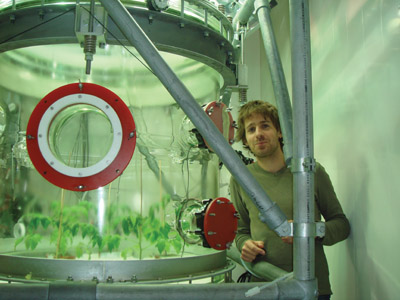 |
|
| Dr. Roel Jansen, with chamber for measuring odours. PHOTOS BY FRED GROVES Advertisement
|
The Dutch greenhouse sector is working to minimize the use of chemical pesticides by, for example, performing detailed crop inspections to reduce the need for spraying. This type of detection work, however, is time-consuming and expensive. The industry needs automated detection of infected plants, preferably at a very early stage of the disease process.
One possible way is to measure plant odours in the air. Wageningen scientists have already shown that plants under attack by insects emit aromatic substances that attract predators.
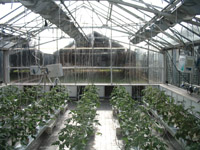 |
|
| (Fig. 3a) small-scale greenhouse containing 60 tomato plants. |
Botrytis is a serious disease in global tomato cultivation. Through a series of tests, Jansen, now a researcher at Wageningen UR specializing in greenhouse horticulture, showed that tomato plants infected by botrytis give off more methyl salicylate into the air, and often in measurable amounts.
Jansen expects a demand for such detection systems. “If you can identify a disease outbreak in a greenhouse in time, there will be even less need for pesticides,” he says. “The trend in greenhouse horticulture is for fewer but larger greenhouses. An outbreak of a disease, therefore, forms an even greater threat as it can easily spread throughout the entire greenhouse.”
Jansen performed his research in close co-operation with the Agricultural Business Economics, Plant Physiology and Organic Chemistry chair groups at Wageningen University and the Jülich Forschungszentrum in Germany.
The research was partly financed by the ESF (European Science Foundation) and Dutch Ministry of Agriculture, Nature and Food Quality (LNV).
A CLOSER LOOK AT THE RESEARCH
■ Crops in greenhouses are typically cultivated as a monoculture, notes Jansen. They are usually grown at a high plant density, and because the climate can be controlled, it is possible to cultivate crops on a year-round basis.
Year-round monoculture crops at high plant density are especially susceptible to diseases and pests due to the ease with which they can spread. Crop protection chemicals are routinely used to reduce the incidence and spread of diseases and pests.
However, said Jansen, consumers are demanding a reduction in the use of crop protection chemicals.
Spot treatments of problem areas with reduced amounts of crop protection chemicals are sufficient if the disease and pest symptoms are discovered at an early stage. “Crops are therefore regularly inspected for these symptoms.”
These inspections are expensive, however, “because they require considerable amounts of time and skilled personnel. As a result, there is demand for a system to inspect crops that discovers plants suffering from diseases and pests. Such a system should preferably warn growers at an early stage of infestation.”
One proposal calls for the measurement of volatile organic compounds emitted from plants. “This concept is based on the numerous studies that showed that diseases and pests have an effect on the volatile blend released by plants. This provides the opportunity to use plant-emitted volatiles for detection of plant diseases and pests.”
THREE MECHANISM TO CHECK EMISSIONS
■ Three mechanisms are regarded as important with respect to emissions from plants upon disease or pest problems.
The first mechanism is the damage of storage pools in plants that contain liquids that are readily emitted after damage. An example is the increase in emissions of oily compounds as a result of damage to glandular trichomes. These glandular trichomes are known as the hairs on leaves and stems. These hairs are damaged as a result of diseases and pests. Detecting increased amounts of these oily compounds in the air may therefore be used as an early warning sign for disease or pest outbreak.
The second mechanism is cell membrane damage. When cell membranes are damaged, several chemical substances are emitted due to the breakdown of membrane lipids. These emissions consist of a blend of saturated and unsaturated six-carbon alcohols, aldehydes and esters. Diseases and pests are able to damage cell membranes. “Detecting increased amounts of these alcohols and aldehydes in greenhouse air may thus be used as an early warning sign for disease and pest outbreaks.”
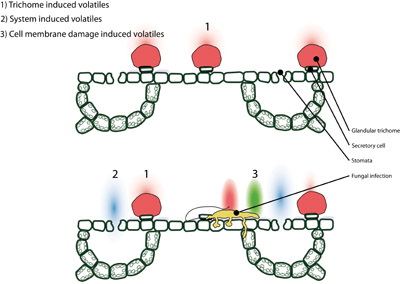
|
|
| (Fig. 1) Three mechanisms are regarded as important with respect to emissions from plants dealing with diseases or pests. |
The third mechanism concerns the systemic response in which plants emit volatiles not only at the site of damage, but also at undamaged sites (Fig. 1). Emissions of these types of volatiles cannot be explained by physical damage only but also involve elicitors of invading organisms including diseases and pests. They may therefore be used to discriminate between damage of plants due to harvest and damage of plants due to real threats.
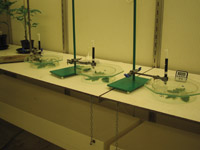
|
|
| Laboratory setup for measuring leaf odours. |
“In summary, a novel approach to discover an emerging disease or pest outbreak would be the detection of volatile organic compounds in greenhouse air,” said Jansen. “These volatiles contain information about the type of damage and may be used to discriminate between damage as a result of regular crop operations and damage from diseases or pests.”
Based on this perspective, the main research objective of the study was to investigate whether plant-emitted volatiles can be used to monitor crops for the presence of diseases and pests in a full-scale greenhouse. The study focused on the detection of botrytis in tomato because this pathogen results in considerable yield losses all over the world.
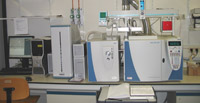
|
|
| (Fig. 2) Gas chromatography mass spectrometry equipment. | |
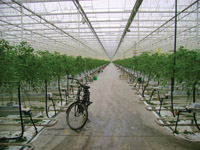 |
|
| (Fig. 3b) Large-scale greenhouse trial with 20,000 tomato plants. |
EQUIPMENT USED AND THE APPROACH
■ An instrument, consisting of a gas chromatograph and a mass spectrometer, was used to analyze the air inside a greenhouse. This instrument is delicate, restricted to laboratory use (Fig. 2). As a result, air samples were transferred from the greenhouse to the laboratory. Experiments were performed at four different levels. They include levels at the laboratory scale in which individual leaves or plants were enclosed in small chambers. These experiments were extended to small-scale and large-scale greenhouses (Fig. 3). ■
Dr. Roel Jansen is a researcher at Wageningen UR in the Netherlands and can be contacted at roel.jansen@wur.nl.
Print this page